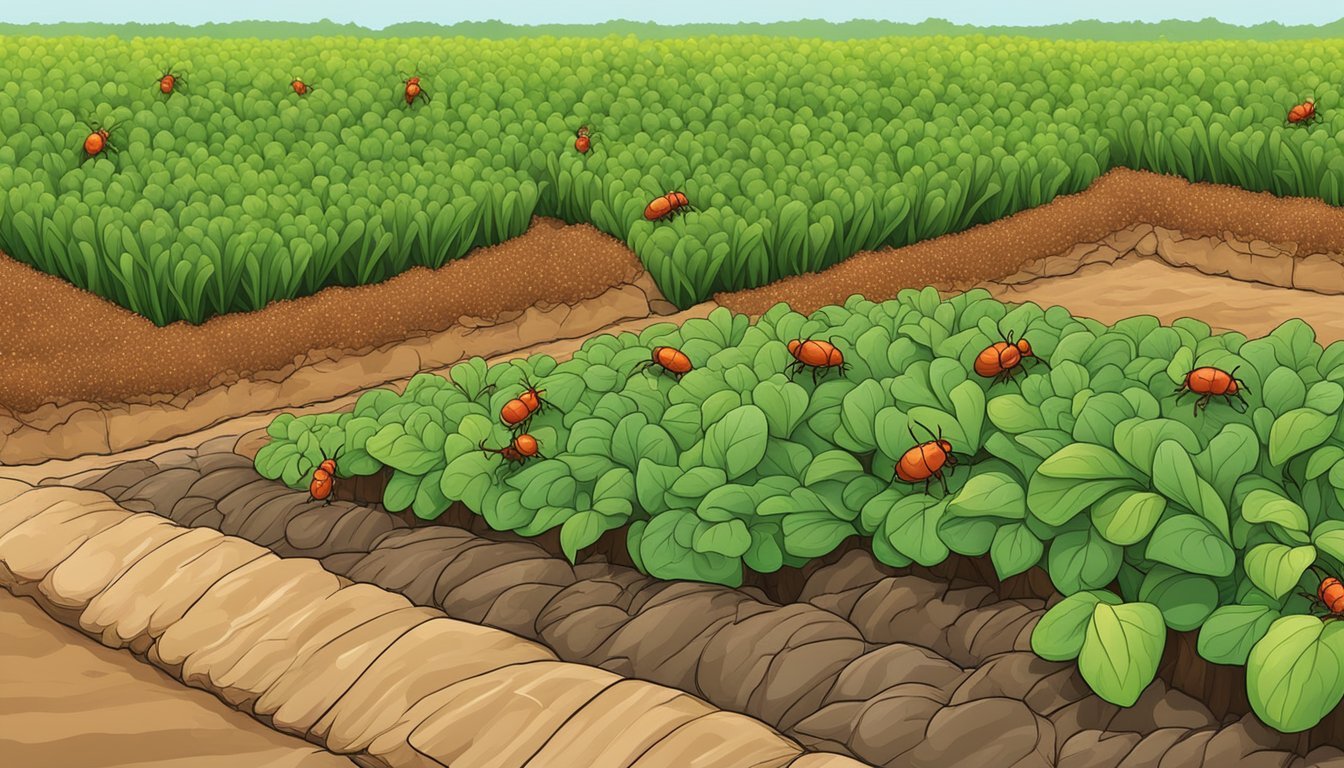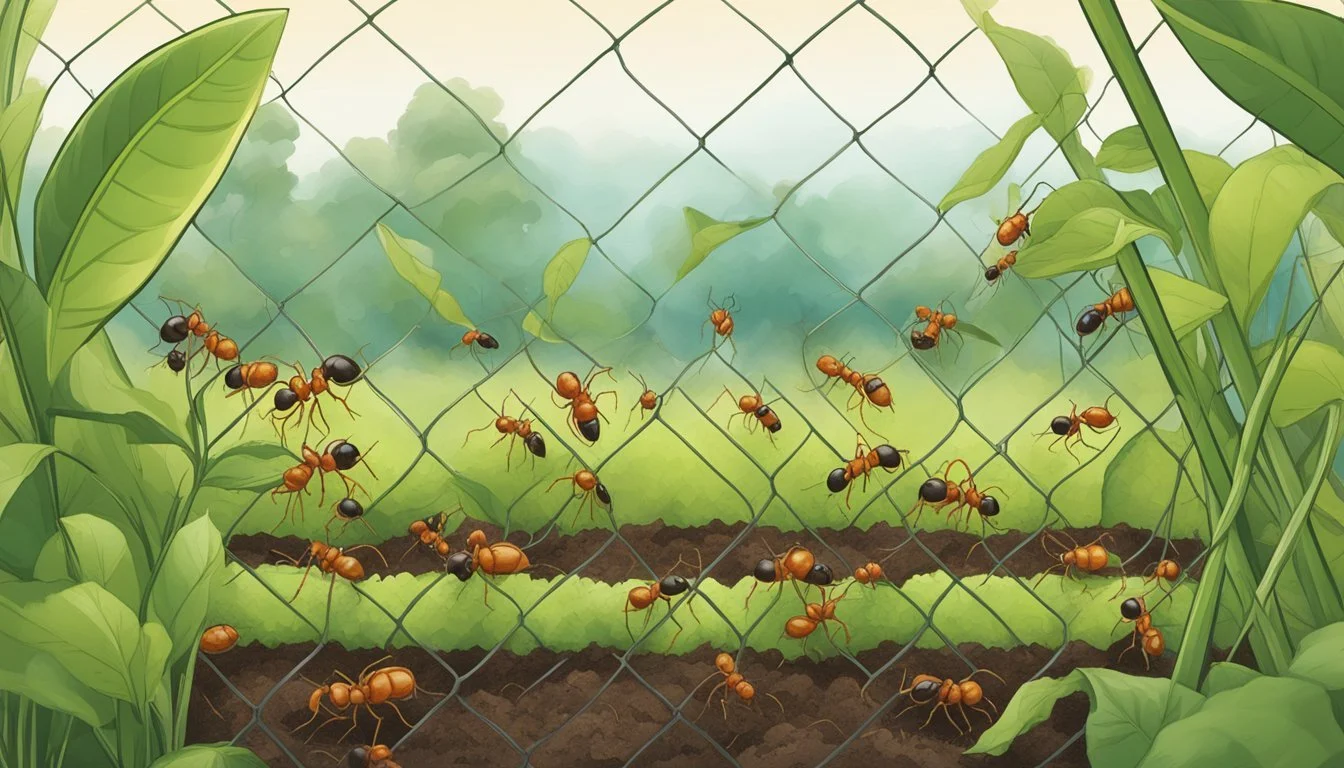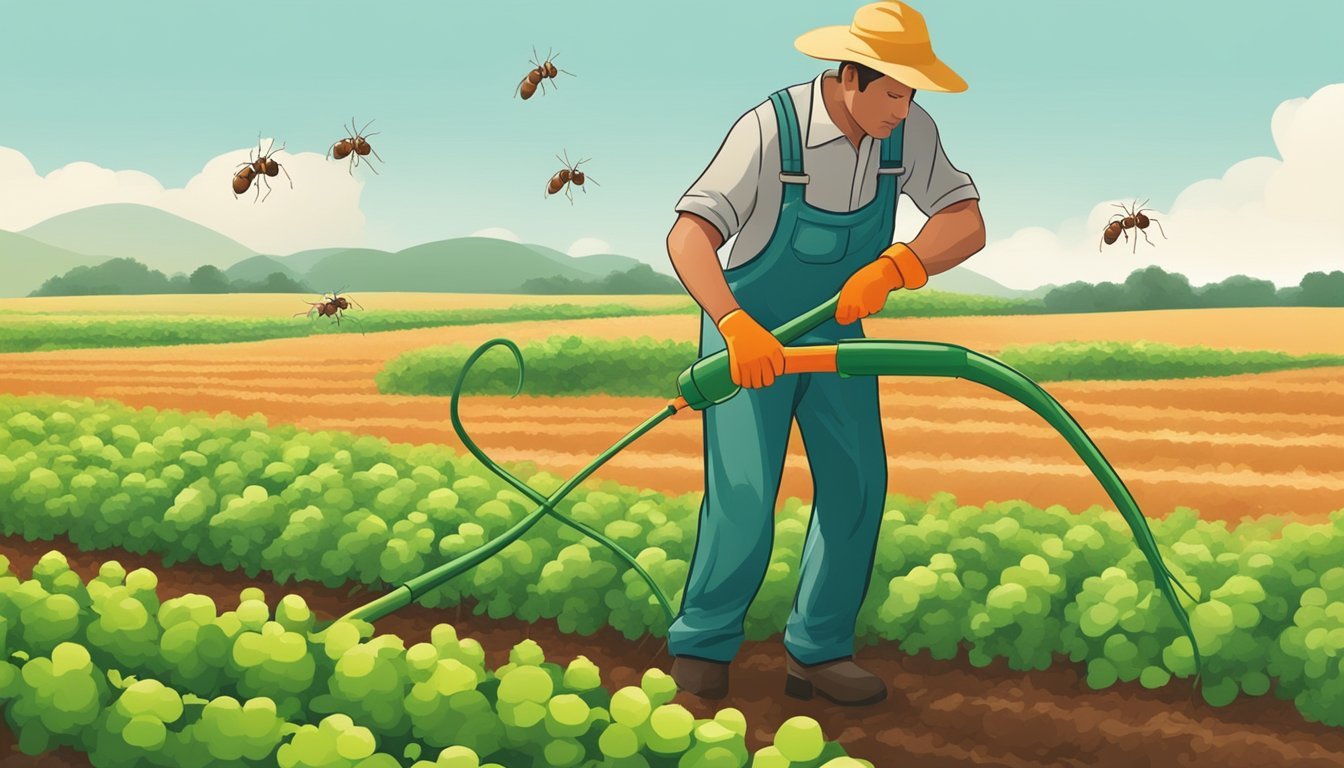Protecting Crops from Red Imported Fire Ant
Proven Strategies and Practices
The agricultural sector is continually challenged by invasive pests, with the Red imported fire ant (Solenopsis invicta) being among the most troublesome. Known for their aggressive behavior and impactful sting, these ants are not just a nuisance but a significant threat to crop health and farm management practices. Originally hailing from South America, the Red imported fire ant has entrenched itself in the southeastern United States, altering the ecological balance and inflicting substantial damage on crops due to their feeding habits.
Devising strategies to protect crops from the voracity of these ants is a critical task for farmers and agriculturists. The Solenopsis invicta species can severely harm the buds and fruits of various plants, with certain crops like corn, soybean, okra, and citrus being particularly vulnerable. Besides the direct damage caused by feeding, these ants can also girdle young trees, weakening and eventually killing them. This behavior extends to a protective relationship with other pests like aphids, compounding the difficulties for crop protection.
In addition to crop destruction, the presence of large fire ant nests poses a direct challenge to farm operations. Farming equipment can be damaged during cultivation and harvesting, leading to increased maintenance costs and potential downtime. Controlling these invasive species demands a comprehensive approach, integrating pest management techniques that are effective, environmentally sound, and adaptable to the changing behaviors of the Red imported fire ant.
Biology and Identification of Red Imported Fire Ants
Understanding the biology and identifying characteristics of the Red Imported Fire Ant (RIFA) is crucial for effectively managing and mitigating the impacts they have on crops.
Characteristics and Scientific Name
The Red Imported Fire Ant, typically referred to as RIFA, are scientifically named Solenopsis invicta Buren. They are a part of the family Formicidae. These ants are recognized for their aggressive behavior and the painful stings they inflict. Solenopsis invicta workers vary in size within one colony, ranging from 2 to 6 mm in length, and are reddish-brown to reddish-black in color. The colonies include a complex social structure with fertile queens capable of laying thousands of eggs, male drones, and various forms and functions of worker ants.
Differences from Native Ant Species
RIFAs are distinct from many native ant species by a few key features. Firstly, RIFAs are invasive and more aggressively outcompete native ants for food and territory. They construct large mounds that can be highly disruptive to agricultural settings, damaging crops and machinery. In contrast, many native ants have less obtrusive nesting habits. RIFAs are also known for their painful sting, which is a reaction to the venom injected, whereas many native ant species do not pose the same level of threat to humans and animals. In terms of appearance, Solenopsis richteri, a species closely related to Solenopsis invicta, can be misidentified as RIFA, but they can often be differentiated by subtle differences in coloration and behavior.
Distribution and Habitat
The invasive red imported fire ant (Solenopsis invicta) is noteworthy for its significant ecological and economic impacts. Understanding its distribution and preferred habitats is crucial for effective management and control strategies.
Spread across States and Countries
The red imported fire ant has established itself predominantly in the southeastern United States, including states such as Texas, Florida, Georgia, Mississippi, Tennessee, and Arkansas. They have spread to other areas such as California, Louisiana, New Mexico, Oklahoma, Virginia, North Carolina, South Carolina, as well as Puerto Rico. Originating from South America, these ants have been transported through human activity to numerous locations globally. The city of Mobile, Alabama was one of the first known US ports of entry for the species.
Habitat Preferences
Red imported fire ants display flexibility in habitat selection, thriving in a variety of conditions. However, they exhibit a strong preference for:
Sunny areas: They are commonly found in open areas that receive ample sunlight.
Moist soil: Ideal habitats often include moist soil, such as river banks or irrigated land, but they can also survive in dry conditions.
The adaptability of Solenopsis invicta enables them to colonize and dominate many environments, outcompeting native species and impacting local biodiversity.
Impact on Agriculture and Environment
The proliferation of the Red imported fire ant (RIFA) has significant implications for both agriculture and the environment, affecting crop yields, altering ecological balances, and resulting in substantial management costs.
Effects on Crops and Farming
The Red imported fire ant has established itself as a formidable pest in agricultural settings, damaging an array of crops like corn, soybean, okra, and citrus. In the process of foraging and nest-building, RIFA can harm plant roots and can lead to loss of seedlings. This ant species has also been known to damage farm equipment and infrastructure, adding to the economic impact on farmers who must invest in intensive pest management strategies.
Notably, hay — often transported between regions — can allow these ants to hitchhike to new, non-infested areas, as pointed out by the USDA APHIS, further exacerbating their spread. The challenge in managing RIFA populations lies in their resilience and their capability to reinfest areas after control measures are applied, necessitating ongoing vigilance and robust management techniques.
Ecological Consequences
Ecologically, RIFA's presence extends beyond the farmstead, adversely impacting native soil composition and biodiversity. Their nest-building activities can lead to soil disturbance, which can affect the growth and health of nearby plants and flowers.
Red imported fire ants exert a substantial ecological impact by preying on and competing with native wildlife, including beneficial insects, birds, and small mammals, disrupting local food chains and ecological functions. In some cases, this can lead to a decline in pollinator populations, which is crucial for many agricultural crops and wild plants. Moreover, their aggressive nature and the potential to swarm and sting en masse make them a potent threat not just to wildlife but also to humans and domesticated animals.
In summary, the incursion of Red imported fire ants into agricultural and natural ecosystems has materialized as a multifaceted threat with significant negative impacts. The challenges it presents necessitate concerted management efforts, research into effective control methods, and cooperation among agricultural stakeholders to mitigate its effects on the economy and environment.
Human and Wildlife Interactions
The invasion of the Red imported fire ant (Solenopsis invicta) presents considerable challenges for humans and wildlife, often leading to harmful stings and disruption of local ecosystems.
Health Risks from Stings
When humans encounter Red imported fire ants, they may be subjected to painful stings that can result in symptoms ranging from mild irritation to severe allergic reactions. Individuals with hypersensitivity can experience shock or, in rare cases, life-threatening anaphylaxis. Immediate medical attention is crucial if someone exhibits signs of a systemic allergic reaction following an ant sting. Moreover, data collected from a decade of research highlights the impact of Red imported fire ants on wildlife, revealing a pattern of injuries to various animals.
Impact on Local Wildlife
The local fauna suffers when these invasive ants proliferate. Their aggressive foraging behavior and competition for resources can lead to a decline in wildlife populations, specifically ground-nesting birds, small mammals, and reptiles. These ants exploit the eggs and young of various species, causing not just direct harm but also triggering ecosystem imbalances. Destruction of native ant populations can often be linked to the proliferation of the Red imported fire ant, as shown in the literature citing their dominance in invaded territories.
Control and Management Strategies
Effective management of the red imported fire ant requires a strategic approach that combines various methods to reduce their impact on crops.
Integrated Pest Management Approaches
Integrated Pest Management (IPM) is a crucial framework in managing invasive species such as the red imported fire ant. IPM emphasizes the use of multiple strategies in a cohesive program to minimize pest damage in an environmentally friendly manner. For fire ants, this includes regular monitoring of ant activity, identifying infested areas, and selecting the appropriate combination of management tactics. These can involve biological control, chemical treatments, and cultural practices that reduce the conditions conducive to ant establishment.
Biological and Chemical Control Methods
Biological control involves the use of natural enemies to suppress fire ant populations. For example, the release of phorid flies, a biocontrol agent, has been part of the USDA's APHIS management programs to control fire ants by preying on their larvae. Chemical control often includes the use of broadcast application of insecticides such as hydramethylnon and s-methoprene, found in products like Extinguish. However, it's crucial to follow the PPQ Treatment Manual for guidelines on proper use to minimize non-target effects and resistance buildup.
Regulatory and Quarantine Measures
Regulatory actions play a vital role in managing the introduction and spread of the red imported fire ant. Quarantine measures enforced by departments such as the California Department of Food and Agriculture (CDFA) involve regulations and restrictions on the movement of plants and soil that may harbor fire ant populations. The Plant Health Inspection Service (APHIS), under the USDA, oversees interstate quarantine and treatment procedures delineated in the PPQ Treatment Manual to prevent the spread of this invasive species.
Research and Outreach
Effective management of the Red imported fire ant (RIFA) hinges on extensive research and the widespread dissemination of findings. Strategic education programs and the continuous development of innovative control methods represent key focuses in combating this invasive species.
Education and Public Awareness
Resources and education are paramount in the fight against the RIFA. Universities, such as Texas A&M, provide valuable information on managing fire ants in urban settings. Efforts to educate the public about medical issues associated with RIFA stings and treatment for injured animals are essential components of these programs. Moreover, interactive identification keys and guides assist individuals in recognizing and reporting sightings to contain the spread effectively.
Future Directions in Fire Ant Research
In terms of future research directions, the focus remains on unraveling RIFA's ecological impact, exploring novel control methods, and assessing their long-term socio-economic consequences. Collaborative research efforts across different regions where RIFA is prevalent, supported by institutions like the University of California, Riverside, are crucial. Many research initiatives are aiming to develop sustainable management techniques that can lessen the ant's adverse effects while being environmentally responsible. The inclusion of new scientific methods, such as genetic analysis, helps in understanding the biology and spread of fire ants, paving the way for more targeted and effective control strategies.
Prevention and Eradication Efforts
Effective management of the Red imported fire ant (RIFA) involves both preventive measures to limit its spread and eradication efforts to eliminate established populations. These strategies require a meticulous approach, particularly in areas of agriculture and trade, where RIFA can cause significant economic and ecological damage.
Preventing Spread through Trade and Transport
The distribution of the Red imported fire ant is greatly influenced by human activities, especially through the movement of agricultural equipment and the trade of goods. To prevent the spread of RIFA, stringent measures are put in place to inspect and treat items like baled hay, nursery stock, and soil-moving equipment before they are moved across regions and state lines. This includes treatments such as soil drenches or the application of granular baits.
Shipping and transportation industries also play a vital role in controlling RIFA spread. Measures taken include inspecting ballast and cargo ships for ant infestations and implementing quarantine protocols to ensure infected materials do not result in the establishment of new colonies.
Eradication Programs and Successes
Eradication programs target areas where the fire ant has established a presence outside its native range. These efforts often involve baiting strategies that aim to eliminate the queen, thereby collapsing the colony. A range of chemical and biological control methods are also employed. Species richness in managed ecosystems, like the longleaf pine forests, is considered when selecting treatment methods to avoid damage to non-target species.
Success in eradication is measured not only by the removal of the invasive population but also by the recovery of the local ecosystem. Eradication can lead to the restoration of ecological balance and the protection of native flora and fauna. Documented successes serve as models for new programs, demonstrating effective strategies that can be adapted and applied to other affected areas.
Environmental Considerations
Effective management of Red imported fire ants requires careful consideration of their environmental impact. The sections below highlight how these ants adapt to climatic conditions and interact with the ecosystem.
Adaptation to Climate and Weather Patterns
Red imported fire ants (Solenopsis invicta) are versatile pests that thrive in a range of climatic conditions. These ants have successfully colonized regions with varying annual temperatures, demonstrating a high degree of adaptability to heat and cold. In areas prone to flooding, they exhibit remarkable resilience by forming living rafts that float until they reach dry ground. This behavior not only aids in their survival but also in the dispersal of colonies to new areas.
Interaction with Native Flora and Fauna
The introduction of Red imported fire ants has significant repercussions for native ant species and the broader native species ecosystem. They aggressively outcompete local ants for food sources and habitat, leading to a decline in ant biodiversity. Furthermore, these invasive ants pose a threat to native fauna, preying upon small vertebrates and invertebrates and disrupting their roles within the local ecology. Their presence can lead to reduced pollination and seed dispersal for native flora due to the displacement of native pollinators and seed dispersers.
Legislation and Policy
Legislation and policy form the backbone of effective management and control strategies in the battle against the Red imported fire ant. Governments at various levels enact legislation and policies to impose restrictions, ensure international collaboration, and adopt measures according to the severity of the infestation and threat to agriculture and public health.
State and Federal Regulations
Federal regulations in the United States categorize Red imported fire ants as a quarantinable pest. This status warrants stringent restrictions on the movement of soil, plants, and other materials that might harbor these invasive ants from infested areas to non-infested areas. The USDA's Animal and Plant Health Inspection Service (APHIS) details the containment strategies and regulatory protocols to prevent the spread of imported fire ants. Compliance is mandatory for agricultural businesses and can include fines for non-compliance.
State laws complement federal ones. For instance, specific states have their own regulations alongside federal ones to manage the internal spread within their borders. These measures often involve mandates for treating infested areas and restrictions on the transport of infested materials.
International Impact and Collaboration
Internationally, countries recognize the need for collaboration to manage the spread of invasive species like the Red imported fire ant. For example, Taiwan has set policies to prevent the establishment of these pests due to their potential impact on agriculture and the environment. Collaborative efforts through international agreements aim to share information, research, and best practices in pest management among nations.
International bodies such as the Food and Agriculture Organization also offer guidance to countries dealing with invasive species, promoting policies that protect against economic and ecological damage. Collaboration extends to sharing of technologies and methods that are successful in detecting and managing Red imported fire ant populations.
Case Studies and Practical Examples
This section examines specific instances of red imported fire ant (RIFA) management and contrasts the varying degrees of infestation across regions, emphasizing the unique challenges and successful strategies employed in protecting crops.
Effective Local Management Scenarios
In California, local agricultural departments have implemented quarantine measures to restrict the movement of plants and soils that may harbor the Solenopsis invicta. Community awareness programs have been critical here, with farmers and homeowners educated on identifying and reporting RIFA mounds. In Florida, a two-pronged approach combining chemical treatments with biological control methods has seen some success in reducing ant populations and limiting damage to crops.
Efforts in Mississippi and Tennessee have focused on integrated pest management (IPM) techniques. Farmers are encouraged to employ regular monitoring systems and use targeted pesticide application only when RIFA presence threatens significant crop damage.
Comparison of Regional Infestations
A comparison of infestations in the southeastern United States reveals that states like Georgia, Arkansas, and Louisiana have experienced varying levels of RIFA infestations due to differences in climate, land use, and the timely implementation of control strategies.
Georgia: Persistent RIFA presence with significant impacts on agriculture.
Arkansas: Moderate invasion levels, focusing on early detection and rapid response.
Louisiana: Faces a more severe challenge, partly due to its humid climate that favors RIFA proliferation.
While New Mexico, Oklahoma, Virginia, Puerto Rico, and North Carolina also report the presence of RIFA, their impacts differ based on local prevention and control efforts. For instance, North Carolina and South Carolina benefit from cooperative extension services that disseminate research-based information to the public, aiding in both education and ant suppression activities.
In terms of scientific study and referencing the scientific name Solenopsis invicta, it’s clear that research plays a pivotal role in understanding the ant’s biology and behavior, which in turn informs the development of tailored management plans for each affected region.
Frequently Asked Questions
In addressing the challenges posed by red imported fire ants, the following subsections provide insightful information on sustainable management practices, effective treatments, and protective measures for agricultural settings.
How can farmers effectively manage fire ant infestations in agricultural lands?
Farmers can manage fire ant infestations by regularly monitoring their fields for ant mounds and employing an integrated pest management approach that includes chemical baiting and cultural practices like flooding or mechanically disturbing the mounds. More information is available from the Texas Imported Fire Ant Research and Management Project.
What are the ecological impacts of red imported fire ants on farmland ecosystems?
Red imported fire ants can negatively affect farmland ecosystems by preying on ground-nesting animals and beneficial insects, which may lead to imbalances. They can also modify the soil structure, affecting water infiltration and soil nutrients. Comprehensive impacts are detailed by the USDA APHIS.
Which environmentally safe practices are recommended for preventing fire ant damage in crop production?
To prevent fire ant damage in crop production, environmentally safe practices include using baits with low-toxicity active ingredients, introducing natural predators of the ants, and implementing mechanical controls that avoid chemical use.
What are the most effective baits and treatments for controlling fire ants in agricultural settings?
Effective baits and treatments for fire ants contain active ingredients like hydramethylnon, methoprene, indoxacarb, or abamectin. They should be applied at the recommended rates for the most efficient control with long-lasting effects. This strategy is supported by guidance from Mississippi State University Extension.
How can fire ants be controlled in organic farming systems without compromising crop safety?
In organic farming systems, fire ants can be controlled using organic-approved baits, boiling water treatments, or diatomaceous earth. These methods align with organic farming standards and ensure crop safety is maintained while managing the ant populations.
What measures can be taken to protect vegetable gardens from red imported fire ant invasions?
To protect vegetable gardens, gardeners should create physical barriers, apply organic bait products, and consider natural repellents like citrus oil extracts. Maintaining a healthy ecosystem with competitive native ant species can also help deter red imported fire ants.









